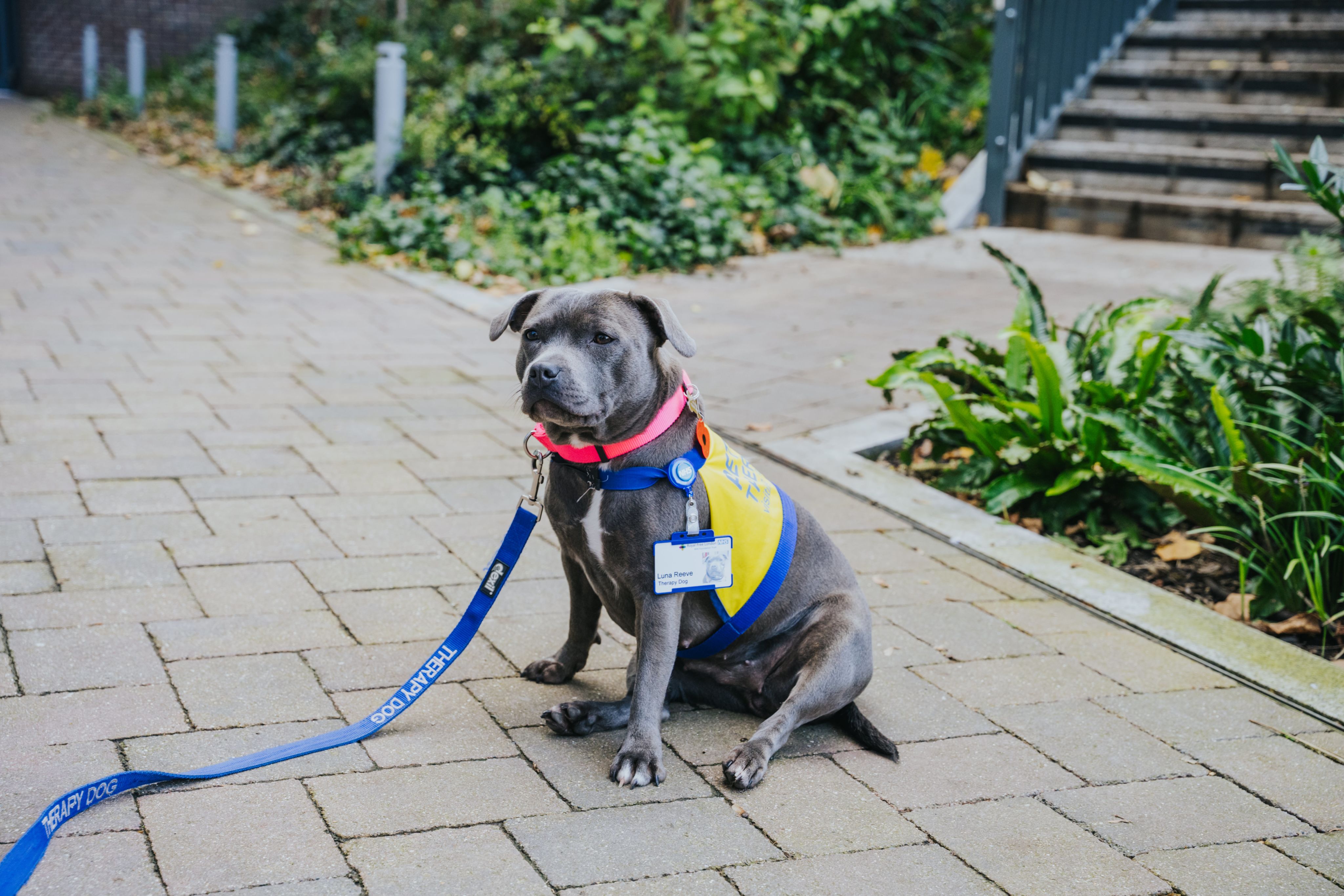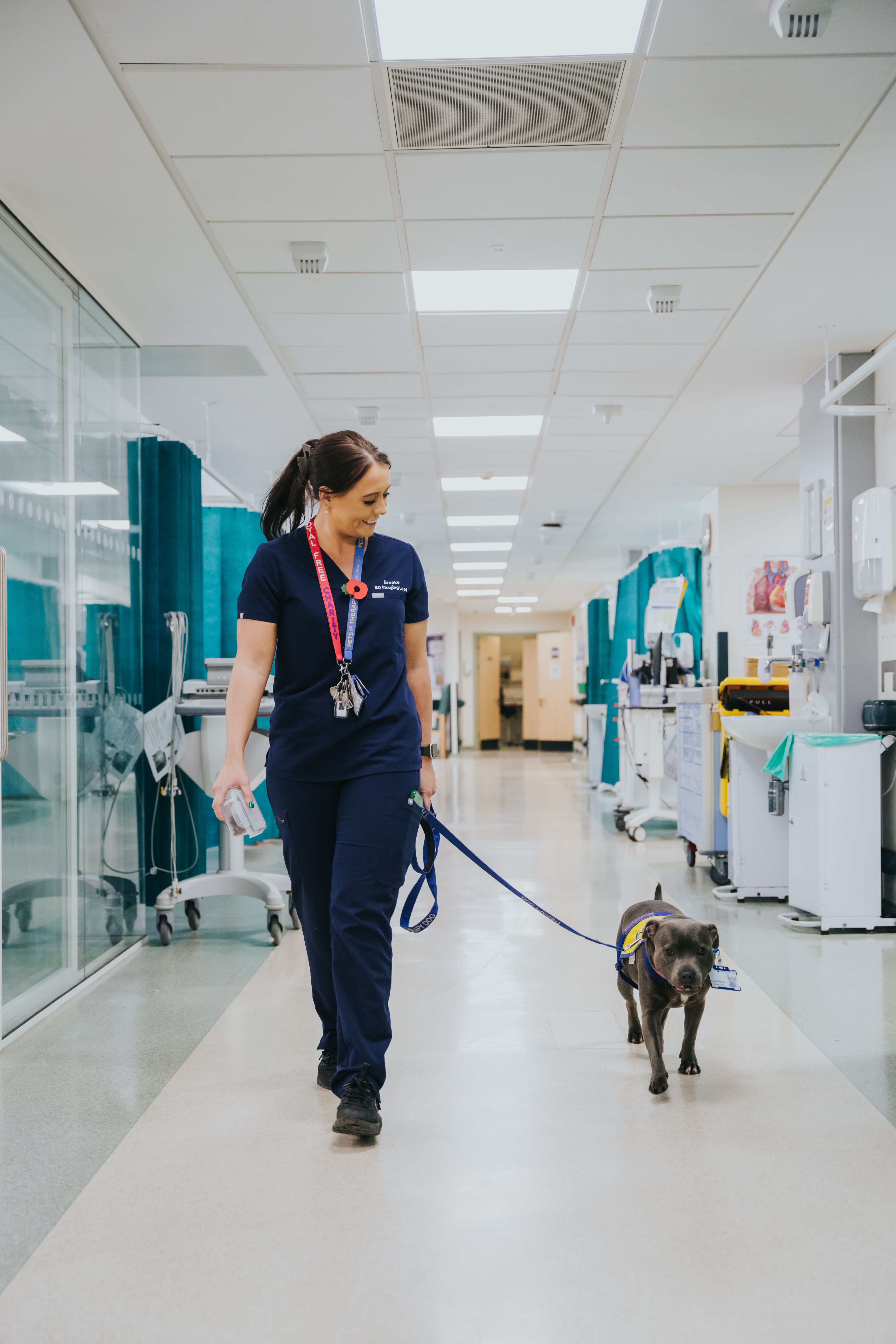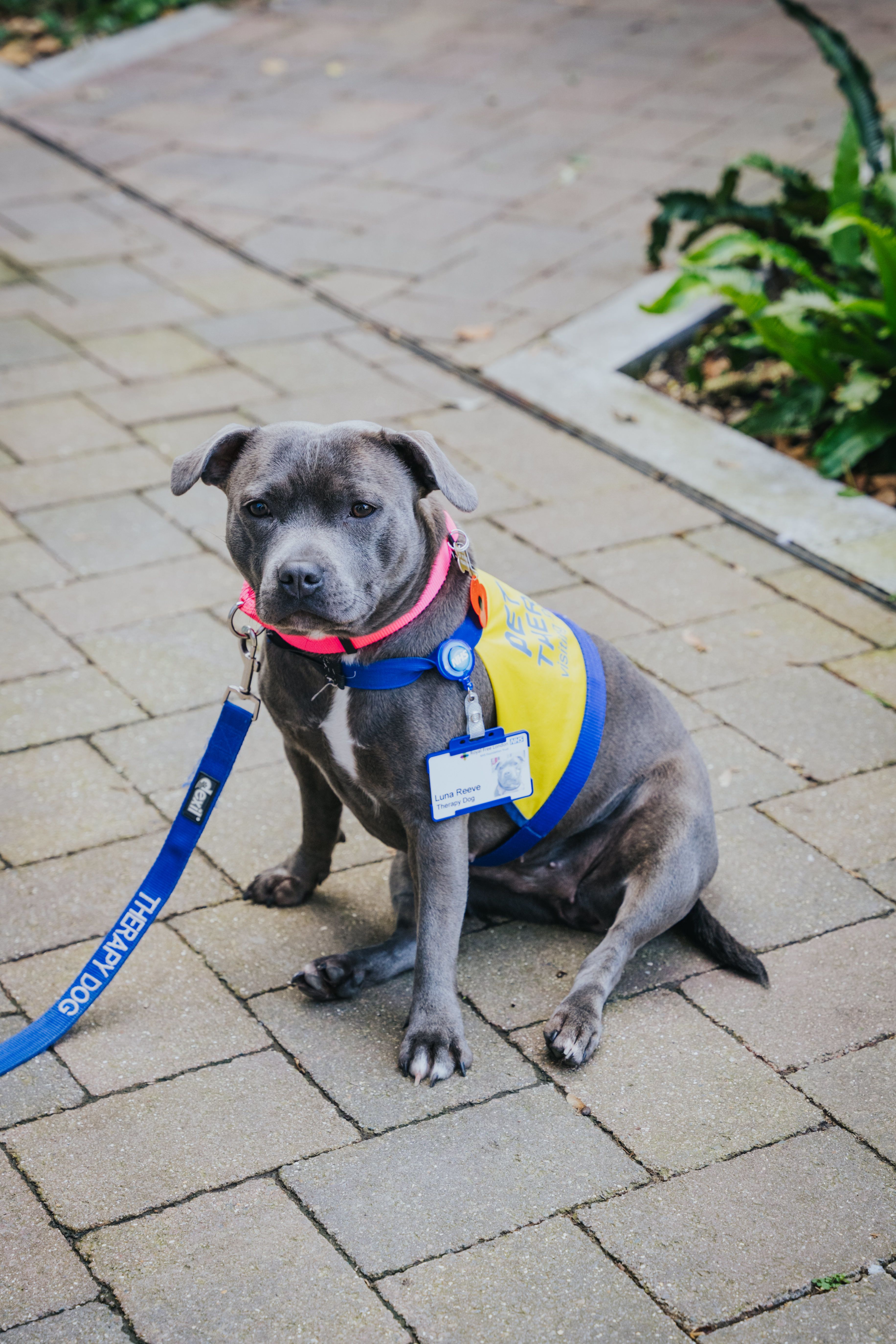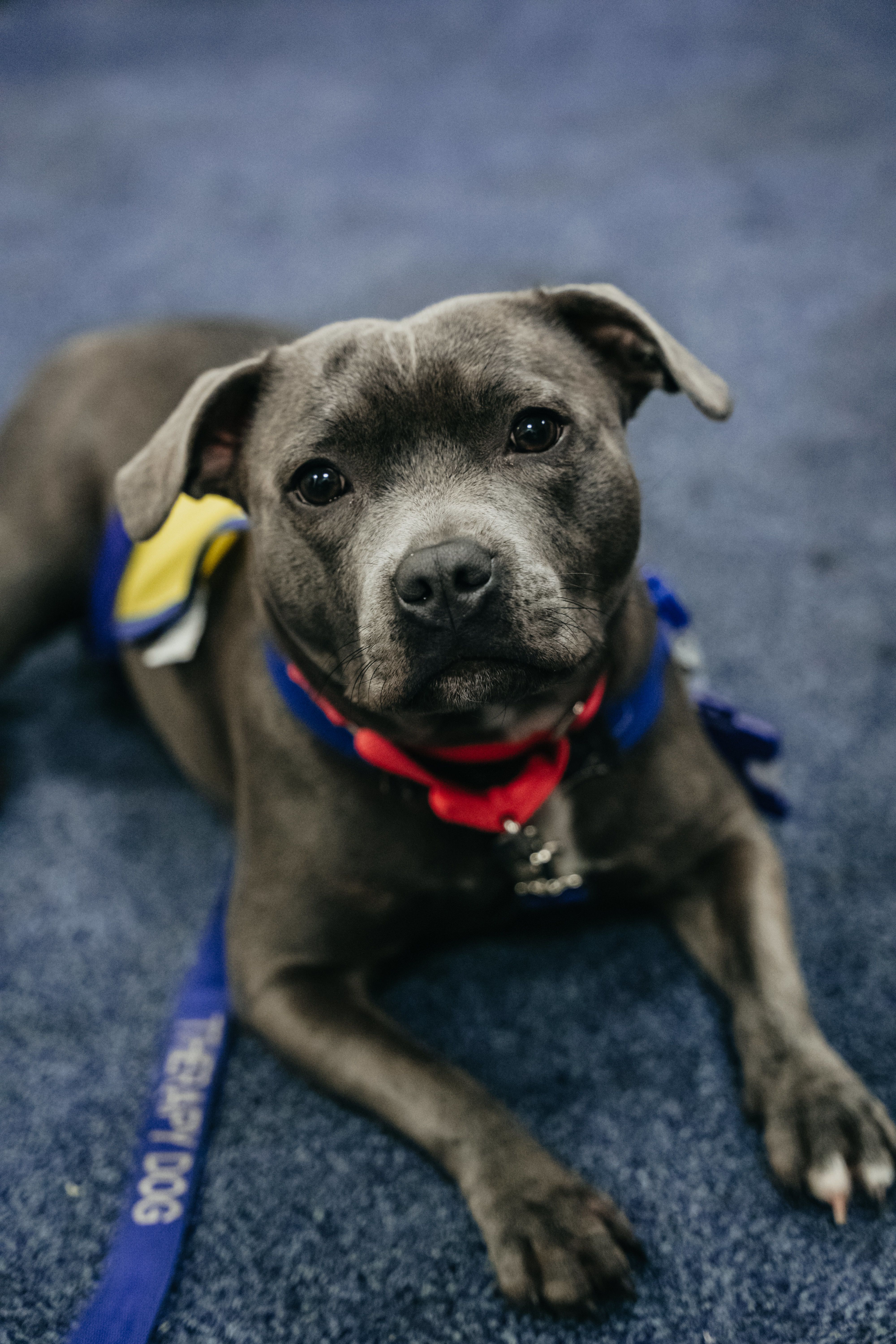
A dog’s life
Synergy joins the President of the Society of Radiographers to meet a canine addition to the Royal Free Hospital’s radiography team
Radiography in the UK is suffering a workforce crisis and staff are finding themselves under increasing strain, meaning departments across the NHS are looking for new ways to help reduce stress.
Luna, a two-year-old Staffordshire Bull Terrier, is a recent addition to the Royal Free Hospital in London, tasked since January this year with helping to ease stress among both staff and patients.
In November, Synergy joined SoR President Dave Pilborough to meet Luna at her place of work, to find out more about how therapy dogs can improve radiography departments.
Cure for a tough day
Luna’s owner Brooke Reeve has been a radiographer since 2012, and has worked at the hospital for the past eight years. She is currently the emergency imaging lead, and during the SoR President’s visit she introduced him to the latest member of the team.
The hospital previously had a number of therapy dogs, Brooke said, who would regularly pay visits to the radiology department.
“I could just see with my own staff that if you’ve had a tough day, or if you’ve had a challenging patient, seeing a dog just brings relief. I could see the relaxing of the shoulders. I’m very much a dog person.”
Since Covid, few therapy dogs have returned to the hospital but when Brooke noticed her dog Luna had the perfect temperament, she saw an opportunity.
“She loved people, loved children, loved other dogs – she’s very soft,” Brooke explained. “She is very good at knowing when to approach and when not to approach. I had staff who were quite scared of dogs, and because of how she is they’ve been able to come and stroke her slightly, or be near her.
“It’s been a very positive experience and we haven’t had any negatives. She’s very good at keeping her distance when she can sense that people don’t want to engage.”
Rigorous training
Luna qualified as a therapy dog last year following a series of training sessions and exams, after which Brooke approached her manager and the Royal Free Charity, which aims to support hospitals, NHS staff, patients and researchers, for the go-ahead.
Brooke’s role as emergency imaging lead means Luna usually accompanies her throughout the hospital, but they try to visit the wards when they can. Most of the time Luna works as a staff therapy dog – which, fortunately, the Royal Free Charity was completely behind.
“They said it would be an amazing thing to do, and would have huge benefits for staff welfare,” Brooke continued. “For me, that was the whole point – to try and give something back to the staff.
“We started coming twice a week in January, and haven’t looked back. We love it. I feel I’ve met so many more people and so many other teams. We had the ALS team come and request Luna at one point.”
While Brooke covers a multitude of areas in her daily work across Accident and Emergency, X-ray and CT theatres, the wards and mobiles, she says she’s still meeting new people every day.
The pair visit the children’s ward to help patients with reading, they visit the dementia wards, and they still make time to go down to the theatres to give staff some relief and help break up the day.
“She loves it,” Brooke said. “She will go home every Tuesday and Thursday and zonk out on our bed. She’s never once not wanted someone to pet her. She’s very much a people person – and she’s got a couple of favourites that she’ll run to!”
Taking the leap
Brooke qualified as a radiographer in Leeds in 2012 before working at Glenfield Hospital in Leicester. She started as a Band 6 radiographer and started working across modalities, before deciding to “take the leap into management.”
“I love it and I haven’t looked back,” she added. “I could never sit behind a desk – even now, in my job in management, I like to be based in the hub of everything.”
Brooke first became interested in radiography after a family friend, who was a breast consultant, introduced her to the world of mammography.
“I was looking at nursing, but I wasn’t too sure,” Brooke said. “I looked further into what we do as radiography – it was amazing. I love working out a puzzle, and that’s how I see our career. You’ve got a patient presenting to you, you’ve got to try and get the ‘gold standard’ of them, but they might not present clearly.
“I love trying to work that out. We don’t always get to follow a patient’s pathway through their time with us, but we do sometimes get to see familiar faces, and as much as we can, we try to make someone’s worst time, while they’re with us, a little brighter.”
Since starting as a radiographer, Brooke has dipped into various aspects of the profession. She worked at the emergency Nightingale hospitals set up during Covid, trained in lithotripsy to break renal stones, has trained to work as a forensic radiographer, and is now undergoing training to be part of the army reserves.
“I was very lucky to offer my support and work at the Nightingale during Covid,” she added. “I worked alongside the army and medics, and I thought actually, looking at the process of what they do, what can I bring back into my career and my working life?”
Brooke explained that the level of teamwork and cooperation that she saw during her time working at a Nightingale hospital inspired her to adopt the same approach at the Royal Free. While there will “always have to be a hierarchy,” the notion of always accepting ideas from team members and trying them out made sense.
Don’t be afraid to ask
When asked what advice she would give to students, Brooke advised not to worry too much about their path into the future. Having graduated without a specialism, she emphasised the importance of seeing what you thought could or should be done first.
“Don’t be afraid! It might seem very daunting, thinking you have to choose a specialism, but don’t worry. I looked at a problem where I thought there was something lacking, something we could do as radiographers, and I approached management and said ‘I would quite like to do this’. Don’t be afraid to ask, is there a gap here? Can I help and support with this?”
At the same time, Brooke warned students not to underestimate the importance of rotational radiography, which she said “in itself is amazing.”
Ultimately, what matters is to “always jump at any opportunity… just say ‘let’s give it a go.’ As long as it doesn’t put anyone at harm, as long as the service doesn’t have a negative impact, we will always try something. Because you never know what will be the next new thing.”
Brooke also noted she had started the world’s first multidisciplinary training sessions within vascular surgery, wherein radiographers, vascular surgeons, anaesthetists, nurses, and representatives from tech company Siemens meet to undergo a training programme conducted live with a machine.
Brooke went on to present her findings and experience of this multidisciplinary session to the Vascular Society, a charity organisation for vascular specialists who treat non-cardiac vascular diseases.
Brooke is also an avid gym-goer, participating in a five kilometre run in the morning before attending the gym in the evening. “I really like fitness, I like to keep fit, and I think that helps mentally as well,” she said.
Before leaving, the President of SoR was shown round the Royal Free by Brooke and Luna, where he had the chance to see the new developments in its radiography department and meet key members of the team – all of whom were also excited to meet Luna.
Brooke added: “With the crew of radiography, a lot is changing. It can seem quite scary with AI coming in but that technology is supportive of us. We are so lucky to be in a career where we have access to so many opportunities. You can really go far – as far as you want to go.”
Brooke and Luna
Brooke and Luna
Luna takes a rest
Luna takes a rest
Brooke, Dave and Luna
Brooke, Dave and Luna
Luna being the best girl
Luna being the best girl
Find out more...
Find out more about therapy dogs and their roles in hospitals via registered charity Pets As Therapy here.





